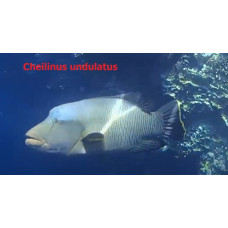Labridae is a family of fishes in the order Perciformes. About 60 genera and more than 300 species are known. They are coastal fish of tropical and subtropical, rarely temperate waters. The body is oval, covered with cycloid scales. Dorsal fin alone with barbed rays in front. The mouth is retractable, armed with strong crushing teeth. The lips are fleshy, wide with longitudinal folds. Fish are solitary or gregarious. Characteristic of caring for offspring. They eat bottom invertebrates (mollusks, crustaceans, etc.), and vegetation. In the Black Sea there are 8 species. Symphodus tinca, up to 30 cm long, which lives among rocks, stones, overgrown with algae, is of local fishing importance.
Among the labridae there are very tiny fish, whose adult length does not exceed 6-7 cm, and huge fish, such as Cheilinus, whose length reaches 2.5 meters and weight up to 200 kg (Cheilinus undulatus).
Labridae are fish with an elongated body covered with large cycloid scales. It has a small usually retractable mouth with thick and fleshy lips, on the inside of which there are folds. Teeth are usually conical or incisor-shaped. Coloration of fish is very diverse and colorful. Fish can combine in the coloration of the whole variety of colors. In many species, the color gamut changes during life, with juveniles sharply different from adults. Also different coloration in females and males. Often females are less bright and may have a completely different coloration than the males, which is why scientists have long attributed fish of the same species to different species. The coloration is observed only in living fish, after death it quickly disappears. Some species may fluoresce. All fish live in coastal areas, with stony and overgrown with algae shores and coral reefs. Feed mainly on mollusks, crushing them with their strong teeth, and other bottom-dwelling invertebrates.
There are species that also eat plant food. They live solitary, each individual occupies its own territorial area, which it protects from others. All fish of this family has an interesting feature - a night sleep, in which they fall into with the onset of darkness. Many of them burrow into the sand at night, and some, like parrot fish, envelop themselves in a slimy cocoon.
Some of labridae deviate from the general type of structure. The tropical Indo-Pacific Gomphosus has a snout very elongated and elongated into a slightly curved downward tube with a small mouth on the end. This allows the fish to retrieve their food from cracks and crevices between rocks and coral bushes. In a very peculiar epibolus Epibolus insidiator the lower jaw is unusually long and protrudes far to the back, and the mouth is able to extend into a greatly elongated funnel.
Among the small labridae, there are so-called scourers that free large fish from ectoparasites living on their bodies or in the gill and mouth cavities. Cleaners include Labroides phthirophagus and other representatives of this genus, as well as juvenile thalassomes. Since these small fish are constantly in one particular place, their predatory clients - Karang mackerel, Lucianas, morays and others, suffering from parasites, visit them as needed and take hygienic procedures, allowing them to work even in their mouths the scourer, which at other times could easily swallow.
in some labridae, as in the already mentioned sea junker, each individual functions as a female in its youth and then as a male. In this species, the ovary first develops, and fish less than 8 cm in length are always represented only by females. Then there is a restructuring of the sex glands and their transformation into testes, so that among the larger fish, exceeding 15 cm in length, there are only males. With the change of sex is also combined with the above-mentioned change in coloration.
Labridae
Tags: labridae



